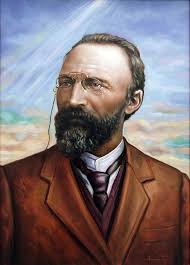
Normally, we take time this year to commemorate the great victory at Lepanto, as we did here and here. Since October is the month of the Rosary, though, I wanted to talk about a different sort of victory won by the Holy Mother of God for Her Son by Her Rosary.
This is Blessed Bartolo Longo. Looks like a nice enough guy, doesn't he? Good Catholic boy, raised in a good and devout Catholic family in Italy back in the mid 1800s. You probably wouldn't have figured him as a priest of Satan.
That's right. He was an officially ordained minister of the Adversary. This is a fall from the faith you normally don't see or hear people talk about. We can't even get people to acknowledge Satan these days, much less take up spiritual arms for him. Even when people do consider Satan, they are more and more thinking of the Anton Levay Carnival version rather than the real thing.
Anyways, Blessed Bartolo's involvement with the occult eventually began to take its toll on him. One of his old buddies helped him gradually back into the Church with the help of some good Dominican priests. Bartolo even went on to become a tertiary in the Order. Scruples remained for him, though. After all, think of the guilt we carry around for our own sins. How do you think you would feel if your past life was as a full-blown ambassador of evil?
It was the Blessed Mother and the Rosary who helped him overcome these feelings and understand that he, too, could be saved in spite of his past sins. He would go on to restore the church in Pompeii and propagate the Rosary as a means of sanctity for all. He went to be with his King and Queen on October 5, 1926 and was beatified by John Paul II in 1980.
It is truly a wonder to reflect on what friends we have in Jesus.
As a true apostle of the Rosary, Blessed Bartolo Longo had a special charism. His path to holiness rested on an inspiration heard in the depths of his heart: “Whoever spreads the Rosary is saved!”.(13) As a result, he felt called to build a Church dedicated to Our Lady of the Holy Rosary in Pompei, against the background of the ruins of the ancient city, which scarcely heard the proclamation of Christ before being buried in 79 A.D. during an eruption of Mount Vesuvius, only to emerge centuries later from its ashes as a witness to the lights and shadows of classical civilization. By his whole life's work and especially by the practice of the “Fifteen Saturdays”, Bartolo Longo promoted the Christocentric and contemplative heart of the Rosary, and received great encouragement and support from Leo XIII, the “Pope of the Rosary”...
In the spiritual journey of the Rosary, based on the constant contemplation – in Mary's company – of the face of Christ, this demanding ideal of being conformed to him is pursued through an association which could be described in terms of friendship. We are thereby enabled to enter naturally into Christ's life and as it were to share his deepest feelings. In this regard Blessed Bartolo Longo has written: “Just as two friends, frequently in each other's company, tend to develop similar habits, so too, by holding familiar converse with Jesus and the Blessed Virgin, by meditating on the mysteries of the Rosary and by living the same life in Holy Communion, we can become, to the extent of our lowliness, similar to them and can learn from these supreme models a life of humility, poverty, hiddenness, patience and perfection”...
As a counting mechanism, marking the progress of the prayer, the beads evoke the unending path of contemplation and of Christian perfection. Blessed Bartolo Longo saw them also as a “chain” which links us to God. A chain, yes, but a sweet chain; for sweet indeed is the bond to God who is also our Father. A “filial” chain which puts us in tune with Mary, the “handmaid of the Lord” (Lk 1:38) and, most of all, with Christ himself, who, though he was in the form of God, made himself a “servant” out of love for us (Phil 2:7)...
At the start of the twenty-fifth year of my Pontificate, I entrust this Apostolic Letter to the loving hands of the Virgin Mary, prostrating myself in spirit before her image in the splendid Shrine built for her by Blessed Bartolo Longo, the apostle of the Rosary. I willingly make my own the touching words with which he concluded his well-known Supplication to the Queen of the Holy Rosary: “O Blessed Rosary of Mary, sweet chain which unites us to God, bond of love which unites us to the angels, tower of salvation against the assaults of Hell, safe port in our universal shipwreck, we will never abandon you. You will be our comfort in the hour of death: yours our final kiss as life ebbs away. And the last word from our lips will be your sweet name, O Queen of the Rosary of Pompei, O dearest Mother, O Refuge of Sinners, O Sovereign Consoler of the Afflicted. May you be everywhere blessed, today and always, on earth and in heaven”.
Pope John Paul II, Rosarium Virginis Mariae

No comments:
Post a Comment